Looking to get better as a welder? Practice is the key.
Having your own welding machine helps you get the practice you need. But there are hundreds of options on the market. What’s right for you?
Read on as we explore our picks for the seven best welders for beginners and what to look for when you go welder shopping.
TITANIUM Easy-Flux 125 Amp Welder
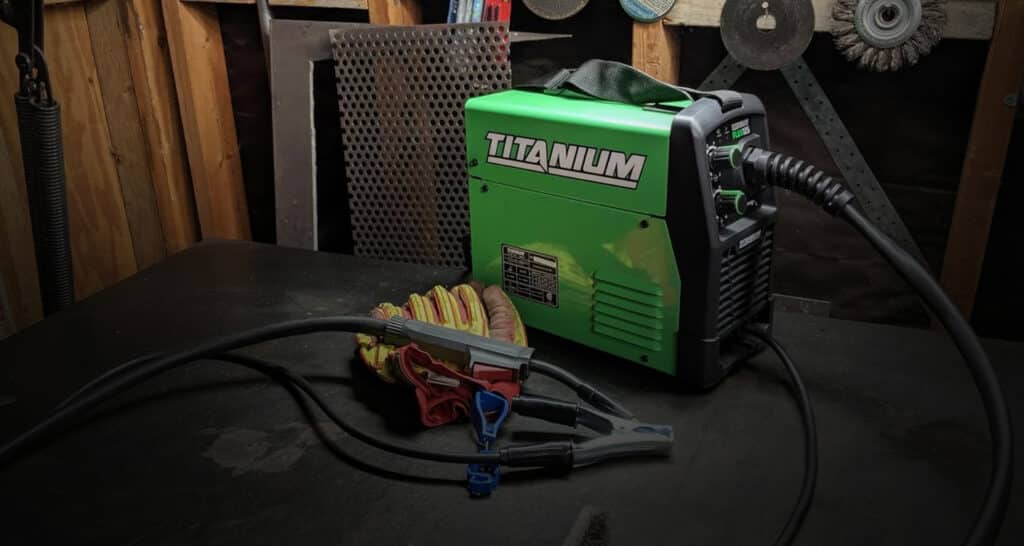
Let’s start on the cheap end of the spectrum. If you’re looking for lots of power and advanced features, look elsewhere.
But any beginner will find a lot to like in the TITANIUM™ Easy-Flux 125 Amp Welder. As a lightweight (a little over 15 lbs.) flux-core machine, it’s great for general welding work on metals up to 3/16 inch thick in your home shop or out in the yard. Plus, its rugged build quality means you can haul it around with ease and without worry about damage.
One of the reasons it’s relatively lightweight is it uses an inverter instead of a transformer. It’s 50+% lighter than transformer-based models.
The 30% duty cycle at 90A won’t have you welding nonstop. You’ll only get 3 minutes or less at a time, in fact. But maybe you need the breaks?
Also, the compact design is vertically oriented, which some reviewers worry presents a tip-over risk. The comparatively weak 90-day warranty is another drawback.
Still, this machine packs plenty of power at 110v for basic welding jobs. The TITANIUM also claims its efficient DC inverter technology produces a steadier flux arc for cleaner welds. That’s certainly a plus for beginners, as flux-core welding is known to create plenty of spatter.
Other beginner-friendly aspects include safety features like thermal overload protection, variable control to help you work on your finesse, and the ability to feed your flux wire before startup. That way, you can focus more on your weld work and less on machine operation.
Finally, the price is right: as low as $150 new. No wonder we picked it as the “best cheap welder” in our general welder buyers guide.
Millermatic 211 MIG Welder
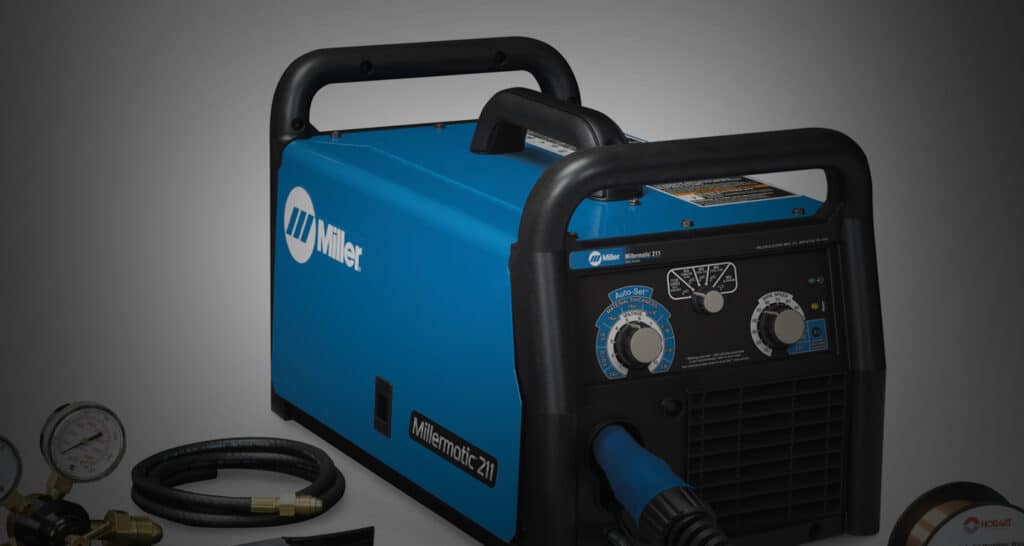
Now we quickly jump up in price—but also the features and performance to go with it.
Designed to accommodate novices while providing lots of room for skill development, the Millermatic 211 MIG Welder is a versatile workhorse that will satisfy the most ambitious beginning welder.
The Millermatic 211 offers impressive performance with a wide range of materials, including mild steel, stainless steel, and aluminum. You can weld materials up to 3/8-inch thick in a single pass, so it’s suitable for a variety of projects and applications.
With both MIG and flux-core capabilities, you can choose the welding method that best suits your needs and preferences. Adding to the flexibility is the convenient multi-voltage plug (MVP™), which lets you connect to either 120V or 240V power sources.
Auto-Set™ technology is a nifty feature that gets beginners welding with minimal hassle and guesswork. It automatically sets the welding parameters based on material thickness and wire diameter—accommodating five different wire/gas combinations and .024, .030, and .035-inch wires— simplifying the setup process and ensuring optimal weld settings.
At 38 lbs., this welder is more than twice as heavy as the TITANIUM. But it’s still plenty portable, with a compact design and built-in handles. It has Miller’s usual rugged build quality, backed by a 5-year parts/3-year labor warranty on the main unit.
With a welding output range of 30-230 amps, a duty cycle of 40% at 150 amps, and a wire feed speed range of 60-600 inches per minute (IPM), you can get lots of different welding work done with the Millermatic 211.
But, of course, you pay for all the good stuff. This welder usually sells for $1,300 to $1,500.
Lincoln Electric POWER MIG 211i Welder
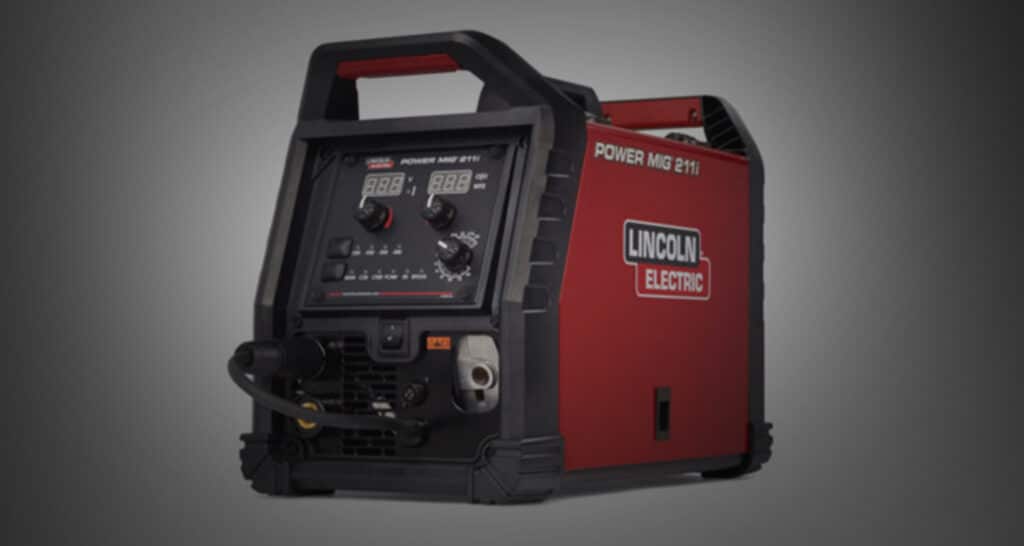
Here’s another top choice for beginners for reliable, versatile welders. The Lincoln Electric POWER MIG 211i MIG welder is a dependable welding pal around the farm, in the shop, or anywhere you need to do repair work.
The POWER MIG 211i lines up closely with the Millermatic in several. It brings multi-process MIG and Flux-Cored, but it adds stick welding capabilities. The result is the versatility to tackle a wide range of welding tasks, working with everything from thin sheet metal to bulkier steel plates. It also offers a capacity of up to 3/8 inches in a single pass.
Note that, for aluminum, you need the optional spool gun. Speaking of which, to be fair, you also need an optional aluminum spool gun for the Millermatic.
Beginners and experts alike will enjoy the user-friendly interface with simple controls and intuitive settings, making it easy to set up and start welding quickly. Its digital display provides clear visibility of parameters, while the simple dials allow you to adjust settings with ease and precision.
Reviewers also highlight a smooth and stable arc from the start, facilitating cleaner welds.
The POWER MIG 211i weighs in at 41 pounds (just slightly heavier than the Millermatic). It also provides built-in handles for ample portability. With Lincoln’s reputation for durability, this welder has a 3-year part and labor warranty.
One more thing it has in common with the Millermatic is price. Expect to pay $1200 to $1,500 for the quality and performance of the POWER MIG 211i.
Hobart Handler 140 MIG Welder
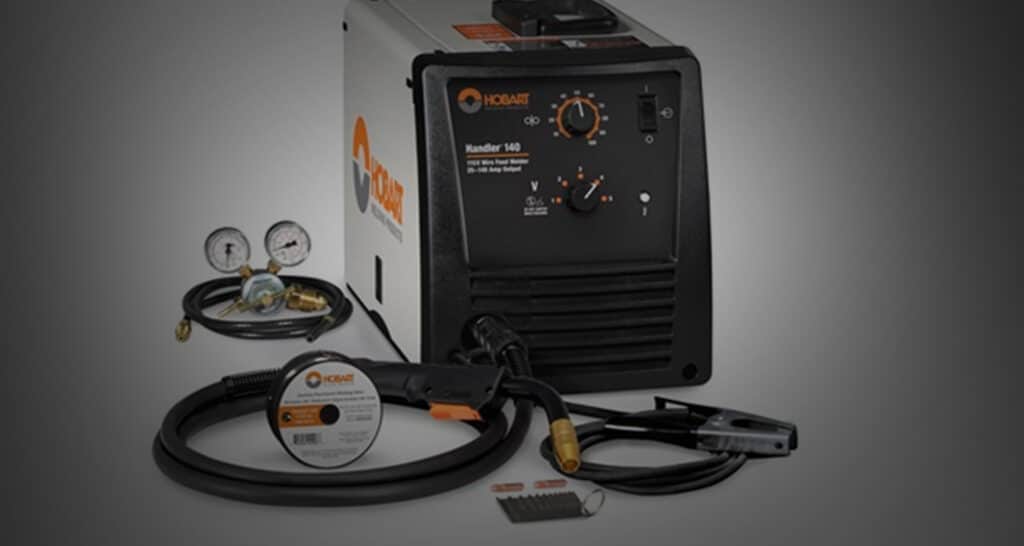
Moving to another famous name in welders, the Hobart Handler 140 MIG Welder is a popular choice among beginner welders for its simplicity, affordability, and reliable performance.
Compared to the Miller and Lincoln models we’ve highlighted, this one retails for less than half the price ($500 – $650). That might make it even more appealing to beginners. Then again, it doesn’t offer quite the same level of performance.
That’s not to say it doesn’t help you weld well. This machine provides a smooth arc with consistent wire feeding.
And with a capacity of up to 1/4 inch in a single pass—plus amperage range from 25 to 140—the Handler 140 can handle a wide range of welding tasks with consistent quality. Meanwhile, the 5-position voltage control selector makes it easy to make adjustments to the task.
As a result, you’ve got a solid companion for everything from auto body work to complex fabrications.
Here’s what else we think you’ll like:
- Versatility – Despite its compact size, the Handler 140 cab welds a variety of materials, including mild steel, stainless steel, and aluminum. It supports both MIG and flux-cored processes, providing flexibility to tackle different types of welding projects with ease.
- Straightforward design – With easy-to-use controls, the simple setup and intuitive interface allow you to start welding more or less right out of the box.
- Portability – At 57 pounds, it’s the heaviest unit on our list so far. But it’s compact, with built-in handles, so it’s still pretty portable. It’s good for working in confined spaces.
- Durable performance – Despite being an entry-level welder, the Hobart Handler 140 delivers reliable results. Many reviewers talk about putting this welder through the wringer and being impressed with its durability. Heavy-duty construction help keep it in top shape.
There’s one big performance drawback: a duty cycle of 20% at 90 amps. That’s a lot of interruptions to prevent overheating.
The heavier weight is also an issue. It’s mostly due to the use of a transformer (instead of a lighter inverter) in the power system.
Nevertheless, the Hobart Handler 140 MIG Welder is definitely a machine you can count on in your budding welding journey.
ESAB Rebel EMP 215ic Stick Welder
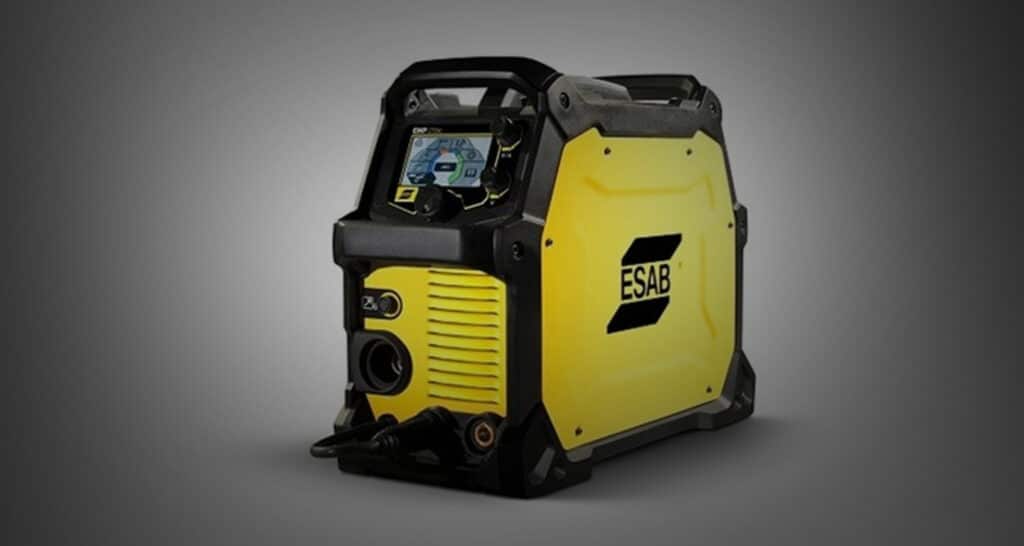
Welders aren’t exactly known for a smart, modern user interface. But the ESAB Rebel EMP 215ic might change that reputation.
With a standout color display and handy Smart MIG technology, this welder is a versatile and user-friendly welding machine. Look to the informative display to tell you everything you need to know—current process, polarity, TIG ramps, even spare parts numbers.
In addition to stick welding, it can do MIG, flux-cored, and DC TIG welding, providing versatility to tackle a wide range of welding tasks—from construction work to light fabrication to whatever repairs you need to do. It works on mild steel, aluminum (with optional spool gun), and stainless steel materials up to 3/8 inch thick in a single pass. You can use it in any position, too.
So, what’s this Smart MIG technology? It automatically adjusts welding parameters based on material thickness and wire diameter, simplifying the welding process. That’s great for beginners, but it can also increase the efficiency of more experienced welders. (You don’t have to use the Smart MIG, by the way, if you want to master these adjustments yourself.)
But it’s not all about the fancy UI. The Rebel EMP 215ic delivers professional-grade performance and reliability. The duty cycle is competitive: 40% at 130A. All told, the system supports consistent weld quality and durability for beginners and experienced welders alike.
Portability is another strong suit. Weighing in at 40 pounds, with a compact design and built-in handles, it’s easy to transport between job sites or around the workshop.
Wherever you carry this welder, it’s built to endure with robust construction inside and out. Plus, it’s got an eye-catching yellow-and-black design that will never be camouflaged, whatever the workspace.
The ESAB Rebel EMP 215ic sells for $1,300 to $1,600 new. But if you’ve got the funds, you likely won’t find a more beginner-friendly stick welder.
Miller Multimatic 215 Multi-Process Welder
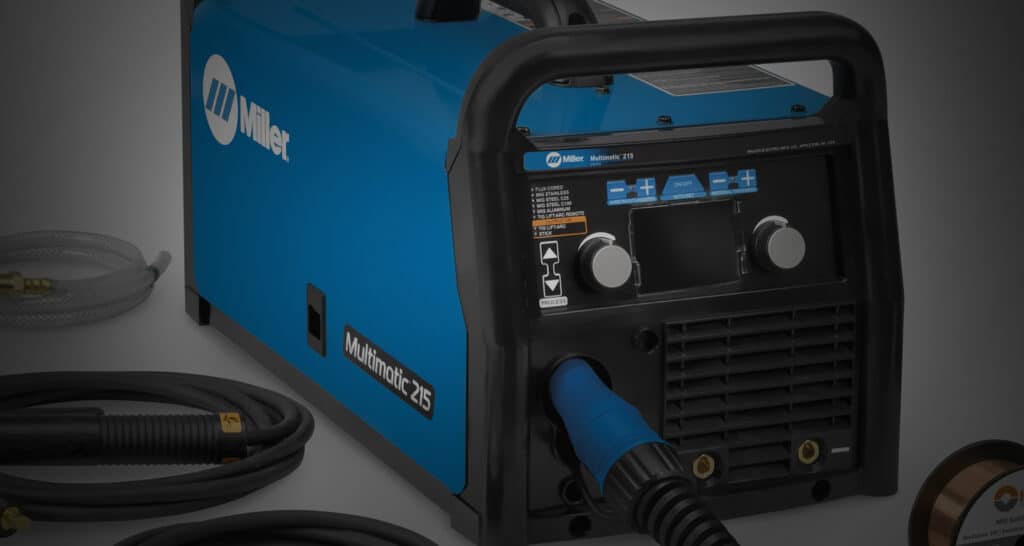
Time to move to the top of line in terms of beginner welders.
The Miller Multimatic 215 is a versatile, feature-rich welding machine that caters to both beginner and experienced welders.
Its multi-process capabilities include MIG, flux-cored, stick, and DC TIG, providing versatility to tackle a wide range of welding projects. It has a welding capacity of up to 3/8 inch in a single pass and the ability to weld aluminum (with an optional spool gun).
Add to that a wide output range of 5 to 230 amps, and you’ve got flexibility for a full array of light- to medium-duty welding work.
Other standout attributes of the Multimatic 215 include:
- Ease of use – An intuitive interface with easy-to-use controls and a bright color LCD screen makes it simple to set up and operate. The Auto-Set Elite feature automatically adjusts welding parameters based on material thickness and wire diameter, eliminating the guesswork and ensuring optimal settings for a variety of welding tasks.
- Efficient technology – Smooth-Start provides a smooth and stable arc initiation, reducing spatter and ensuring clean weld starts, even for beginners. Meanwhile, Pro-Set lets you fine-tune welding parameters manually for customized results.
- Duty cycle – Another area that’s a big step up from others on this list. A 60% duty cycle at 150 amps means a lot of uninterrupted, high-performance welding.
- Durability – This is a Miller, so you can count on high-quality, rugged construction and advanced features to ensure consistent weld quality and performance, time after time.
About the only thing you might not like is the price. The Miller Multimatic 215 sells for as much as $2,500 new.
Lincoln Electric POWER MIG 215i Multi-Process Welder
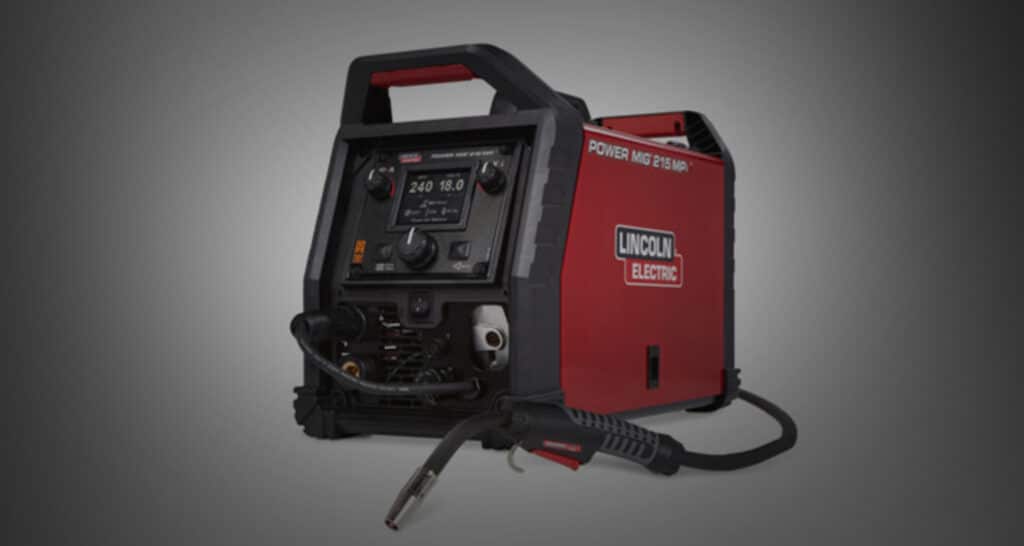
Rounding out our list, the Lincoln Electric POWER MIG 215 MPi lines up well with the Miller Multimatic 215.
It’s a versatile and user-friendly welding machine that’s well-suited for beginners but with plenty of oomph for more experienced welders. This is Lincoln, after all. So expect professional-grade performance, rugged construction, and advanced technology to ensure consistent weld quality.
Multi-process capabilities include MIG, flux-cored, stick, and DC TIG welding, providing versatility to tackle a wide range of welding tasks. You get a welding capacity of up to 3/8 inch in a single pass, along with the ability to weld aluminum with an optional spool gun.
Coupled with output up to 220 amps, you’ve got plenty of flexibility to handle various materials and thicknesses. It’s a well-rounded workhorse for all kinds of hobbyist projects, home repairs, and light industrial work.
And no matter the job, you’ll find it easy to use. The intuitive user interface offers simple controls and a large color display, making it easy to set up and operate. Ready.Set.Weld is a nifty feature that simplifies the welding process, letting you establish and save optimal settings with minimal effort.
At 48 lbs., the POWER MIG 215 MPi is heavier than the Miller Multimatic 215. But it’s still easy to haul around, with a compact, ergonomic design and built-in handle. The dual input voltage—120V or 230V—capability means you can plug it into whichever power supply is available where you go.
What about the duty cycle? That’s an impressive 60% at 170 amps—slightly superior to the Miller Multimatic 215.
One more thing that compares favorably with that Multimatic 215: price. You can find the Lincoln Electric POWER MIG 215 MPi for as low as $1,500 new.
What to Look for in a Welder
With that overview of your top welder options for beginners out of the way, let’s look at what you need to consider to make sure you get the right machine for your needs.
Buy for Your Skill Level

In our list, we highlighted welders that focus on several different process capabilities. But keep in mind that some welding processes are better for beginners than others.
To avoid frustration, it’s important to consider your skill level (and your skill development goals) in the context of the welding process:
- Flux-core arc welding (FCAW) – Easy to learn, and the equipment tends to be lower cost.
- MIG (metal inert gas/gas metal arc welding / GMAW) is also relatively easy but comes with a higher price tag.
- Stick (or shielded metal arc welding / SMAW) – Easy to learn but hard to master.
- TIG (tungsten inert gas/gas tungsten arc welding / GTAW) – The most difficult, specialized welding process.
For most beginning welders who aspire to more advanced skills, a good MIG welder is a fine starting point. Or a multi-process welder if you can afford the cost.
Conversely, if you’re on a tight budget, get a flux-core machine as long as it’ll work for your needs. Flux-core-only machines tend to be really cheap, and you don’t have to worry about having to buy gas.
TIG is best avoided for beginners. See how it goes with other processes first before investing in a true TIG welder. Otherwise, you’re likely to get frustrated, lose patience, and end up with an expensive TIG welder collecting dust.
Buy for Your Use Case
Just as important as buying for your abilities is buying for you’ll actually be welding.
After all, if you don’t need a particular welder to do your work, you won’t use it—and you won’t learn!
Here’s a snapshot of the application considerations of the different core processes:
- Flux-core / FCAW – Ideal for welding outdoors because there’s no need for gas. That also means it’s not as expensive. But it only works with steel, and only with thinner metals at that. It also doesn’t produce clean welds. Outdoor repair work is its bread and butter.
- MIG / GMAW – Great for general repair or fabrication. Think auto body work or general repairs. Unlike FCAW, you can weld more medium-thickness materials, including aluminum, with clean results. But MIG still can’t weld thick pieces. It has to be done indoors due to the need for shielding gas. Also, these machines are pricier than flux-core units.
- Stick / SMAW – A fine choice for heavy duty repairs and other metal work indoors and outside. In fact, it’s better suited to outdoors due to the spatter and fumes it creates. Stick only works with steel and cast iron. And don’t expect smooth results.
- TIG / GTAW – What you need if you’re doing high-quality work or welding on specialized metals. But again, TIG is tough. We highly recommend you work up to it.
Buy the Amount of Amps You Need
Within any welder category—even with a given product line—there’s still a range of models to choose from.
A key difference lies in the amperage output. Those numbers you see in the product names often refer to the amps.
It’s an important thing to know, because the output determines the thickness of metals you can weld. So, 140A is going to enable welding materials up to ¼ inch thick.
Want to work with double that thickness (to ½ inch)? You need more amps! Up to 250, to be exact. Don’t overlook this spec if you need to weld thicker metals!
One Final Power Consideration
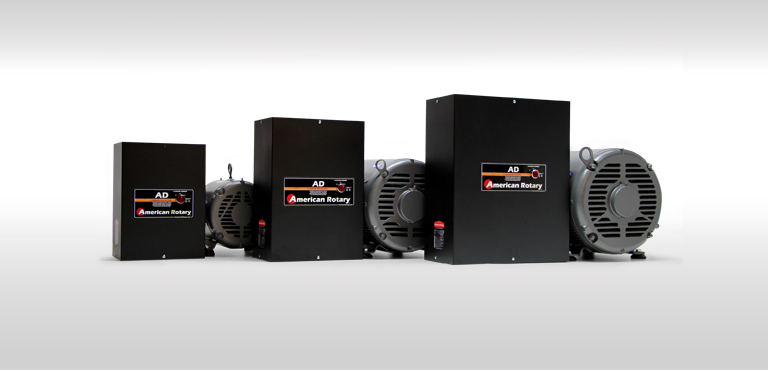
You might not be looking to weld the thickest materials out of the gate as a beginner.
But as your skills advance, you might decide to amp it up, so to speak. If so, here’s an important consideration: a three-phase machine enables more power and efficiency for higher-amp welding work.
The trick is how to power that machine. You likely have single-phase electricity where you’re working. Fortunately, a rotary phase converter can convert that single-phase into the 3-phase power you need.
For example, USA-made American Rotary AD Digital Smart Series converters provide smooth 3-phase for voltage-sensitive equipment such as welders.
One of our units can also power all kinds of other equipment at the same time. So, if you’re advancing as a welder and taking on other DIY work, too, we’ll keep you up and running and learning all along the way!



